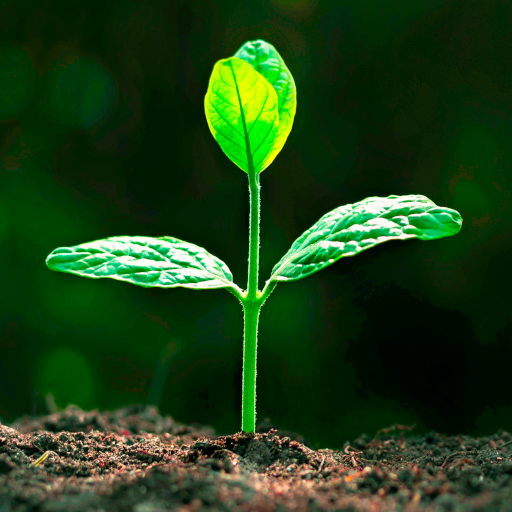We recently had a group activity held at Serge and Maria’s place. It started with the regular seed saver meeting, which is where we pack the seeds that we sell through the group. This is always a good morning, as we chat while we pack the seeds. It fills the People Care ethic well! Community is so important and just sitting down chatting to people that share the same interests as you, is very fulfilling. After we filled the seed packets that needed doing, and after a yummy morning tea, we went for a walk through the garden. Then in the afternoon, we had the seed saver workshop facilitated by Serge and Shane Simonsen.
I took a few notes and pictures of the garden, as it is truly inspiring! I find it inspiring, because I love a tidy productive garden. I can do productive okay, but tidy is an impossible task for me.
- Sawdust on paths and then when this is broken down, it gets put onto the garden bed and more sawdust goes on to the path
- New Beds – the old sawdust, biochar (from his pizza oven), organic life fertiliser if needed for a high nitrogen crop, compost and then aerated, but not turned over
- Potatoes – makes a hole with a hand held post hole digger, put the potato in and back fill with that soil, as they grow, sawdust is added to mound up around the plants

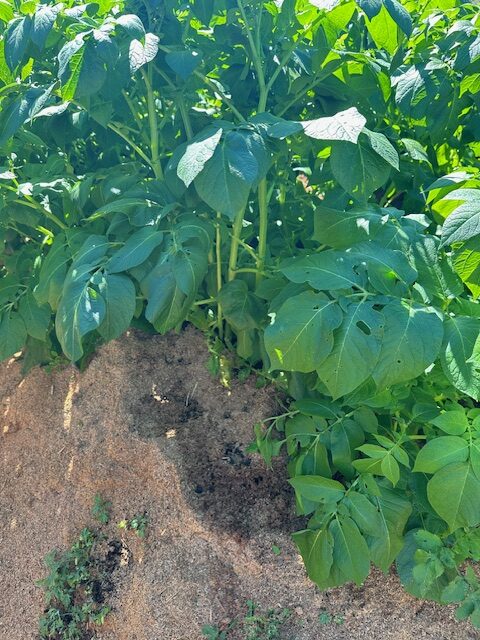
As the potato plant grows, sawdust is mounded around the plant. When digging the potatoes they are very clean.
- Onions don’t like their roots disturbed so weeding can be a problem. Burn the soil before planting to stop any weed competition. The onion seedlings are quite large when transplanted.
- Kailaan (Chinese broccoli) is a plant I’ve heard of but not seen. It’s supposed to be a better one for us to grow in the sub tropics than proper broccoli.

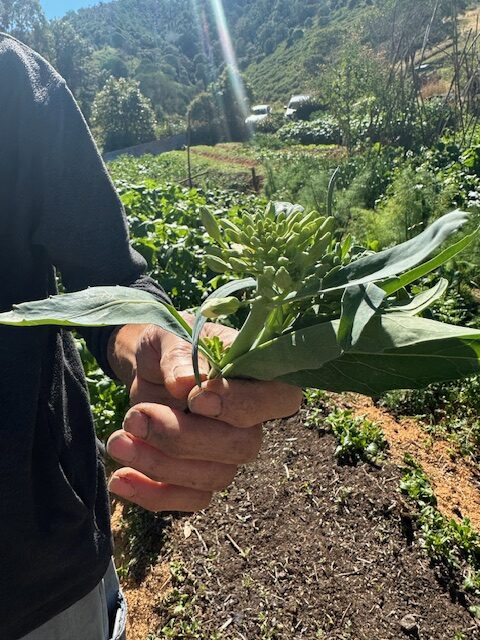
- Asparagus – It was suggested by Shane that when mulching over winter, you should sprinkle the asparagus patch with some salt and some seaweed, as they were originally a sea marsh plant.
There was also the most amazing cauliflower, which is one that should be kept for seed, as you should always keep your best fruit to keep seed from. But how tempting to eat this one!?
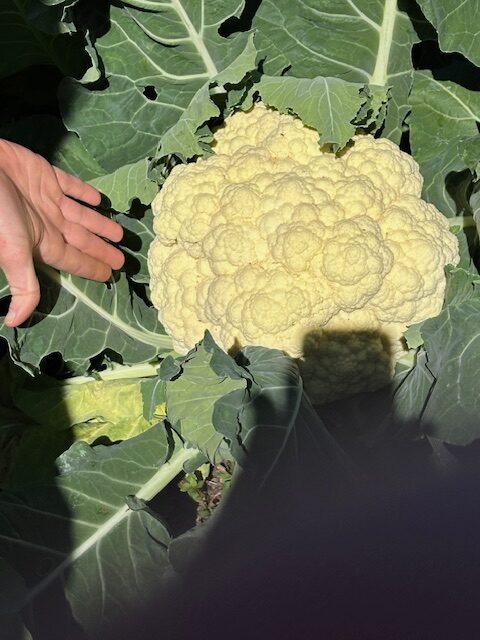
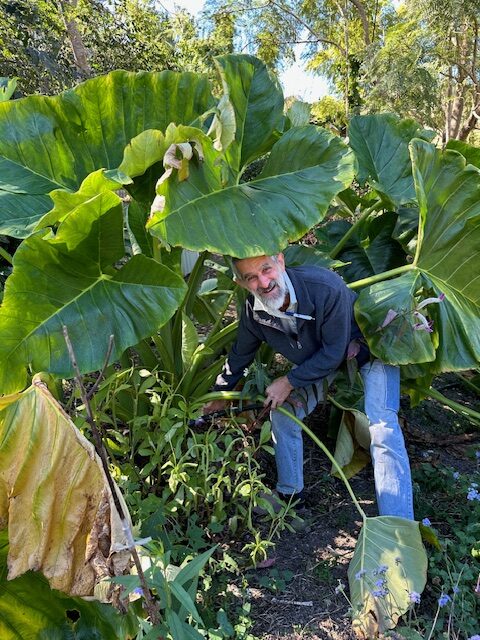
That is a huge cocoyam too!

Broccoli is looking good!

As is the lettuce and the snow peas.
Seed Saver Workshop
Dr Shane Simonsen is a self-described experimental farmer. He has been trialling, selecting and breeding plants that want to grow in our environment in this area. He writes on Substack and can be found here https://zeroinputagriculture.substack.com/
Shane started the discussion by explaining a little about plant biology, however because I failed biology, I can’t repeat what he said, in a way that will do it justice. As permaculture gardeners, we like to plant heirloom varieties of plants, however these plants have been developed a long way away from here. We need to start growing our own Gympie varieties. That was the purpose of the afternoon: to encourage us to start saving our seeds from plants that are acclimatised to this region.
To do this, Shane takes it a few steps further than most of us do – he has established his own breeds of various plants by cross breeding. For example, he is crossing the vigorous wild cherry tomato with less tough domestic varieties. Tomatoes self pollinate, so to cross pollinate takes a lot of physical intervention and difficult to explain. He also suggests that we need to be less diverse and grow 2 or 3 varieties of plants that grow well here. Using tomatoes again, this would mean working out which varieties grow well and keep these seeds and grow these rather than buying 10 different varieties, some of which won’t do as well as others.
Shane has reached out to all parts of the world with old growing traditions and got some of their seeds. Aquis has a list of seeds that we are able to import. Staple crops are foundational and Shane’s latest and a long running project is to work on hybridising the Bunya Pine tree. He’s hoping to cross this with a South American tree of the same species called a Parana Pine. In fact he’d love to here from people in this region that would like to grow Bunyas and Parana’s. A hybrid cross could increase the productivity and they may even produce nuts sooner than the traditional bunya pine. If this is something that might interest you, stay tuned and we may get together with Shane and discuss what we can do as a group.
Serge then took over with a practical discussion and demonstration of seed saving. Starting with cucumbers, which is a wet method of seed collection. Always leave the fruit on the plant until it is mature. Cucumber seeds need to be left to ferment a little to enable the removal of the flesh around the seed. By leaving the fruit until it’s very mature, this is much easier. Also, keep seeds from the best specimen.
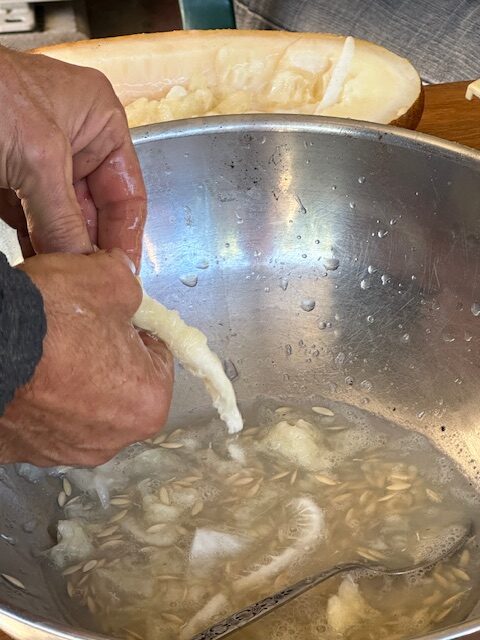
The bigger fleshy bits are removed and then you strain off what you can and wash the seeds several times. Place in a jar and give a good shake. Strain and repeat washing and shaking until there is no froth on the top and you can strain the seeds from the fleshy stuff.
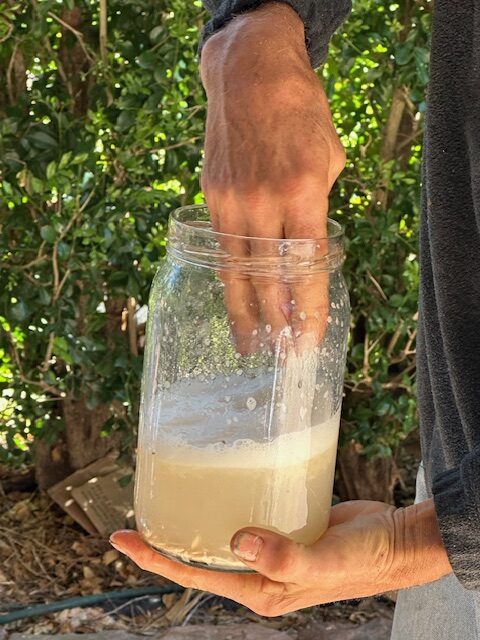
To dry the seeds, spread on paper towel or an old tea towel and air dry. Once dry, place in plastic box with a drying agent. The preferred drying agent is epson salts. You need to dry the epson salts first, by putting them in a tray in a hot oven (200C). It will melt into a block. Use this in the base of a plastic box and place the seeds in paper bags on top of the salt and cover the box. Then transfer to a bulk storage container – put the seeds in snap lock bags in a container with the drying agent again. The epson salt block does need to be re-charged over time by drying the same way in the oven. All seeds should be stored in this way as moisture is the enemy of seeds and our climate is so humid, the air always has moisture in it. You can store smaller amounts of seeds in containers with the small oxygen absorbers that come in containers of medication.
The dry method of seed saving is obviously dry – you don’t use water. Lagos spinach was the example used, but lettuce or herbs would be similar. Cut the seed heads off and place in a bag and shake until the seeds fall out. Lagos spinach needs to be collected when it is only half ripe, as it takes a long time for the whole seed head to ripen. Most plants for dry seed saving need to be completely mature and dry on the plant first. Beans and peas should stay on the bush until they are dry and rattly. When working with small seeds like the lagos spinach or brassicas, pour through a set of three sieves. Coarser on the top, down to the finest on the bottom. This way you get rid of the chaff first. You may need to winnow it afterwards to get final bits of chaff out. This is when you pour from one container to another in the breeze. The wind blows the chaff away, leaving the heavier seed to fall into the second bowl.
Another thing that you need to try and remember is the variety of the plant. I find this the hardest part, remembering which variety of plant I planted. However, if we start keeping our best produce for seeds then does it really matter what variety it is, if it grows well in the area and we are sharing with our fellow gardeners?
It was a great opportunity to learn from two very experienced seed savers. Thanks to both these men, we may be brave enough to start saving and sharing our seeds. Or even supplying them to sell through the Seed Saver group.
